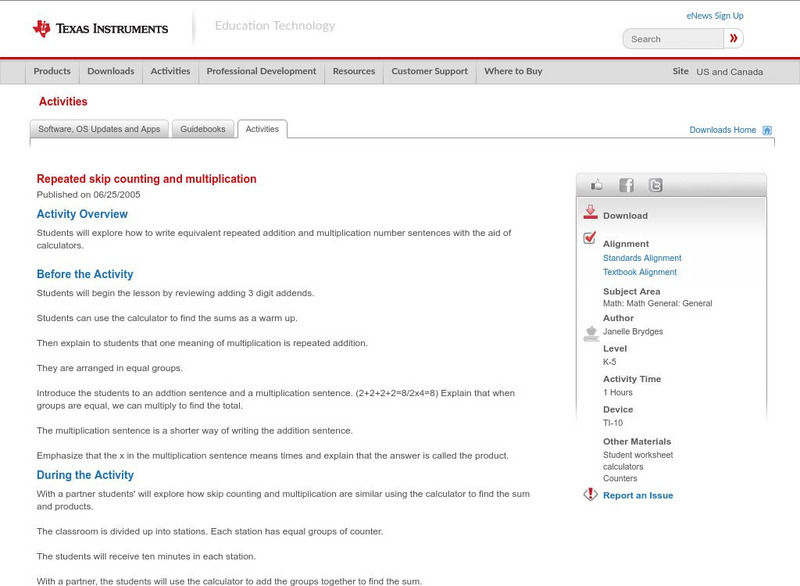Curated OER
Conservation vs. Economic Growth
Investigate the choices people make between economic growth and personal growth and development using the ethical/decision making model. Small groups create and present a position paper describing their feeling for or against the...
Virginia Department of Education
Organizing Topic: Probability
The probability is high learning will occur! A well-designed unit introduces learners to the concepts of independent, dependent, and mutually exclusive events. Using Venn diagrams, the lessons ask learners to analyze many different...
Curated OER
Ziplock Chemistry
Students investigate various chemical reactions when creating mixtures in ziplock baggies. In this chemistry lesson, students will recognize various chemical reactions and cite evidence. Safety and assessment strategies are included in...
Curated OER
Acting in Marriage-Is It on Stage or Off?
Students compare views of marriage in Macbeth and Cat on a Hot Tin Roof. In this comparative literature lesson, students discuss and debate the marriages of Macbeth and Lady Macbeth in Shakespeare's...
Curated OER
Immigration Unit
Third graders develop an appreciate for the various cultures that are present in their local community. Through reading and research, they explain how various culture came to live in their area. At the conclusion of the unit, 3rd...
Curated OER
Partial Quotients
Fifth graders examine the partial-quotients algorithm for finding the answer to a division problem. In this partial quotients lesson, 5th graders demonstrate the process of division through a series of estimations....
Curated OER
Fractions
Students solve problems with fractions without using a calculator. In this algebra lesson, students practice reducing, converting, adding, subtracting and multiplying fractions. They apply the use of fractions to the real world.
Curated OER
How Hazardous Substances Affect People
Students examine the health effects of hazardous waste on people. They work together to complete an experiment in which worms are exposed to chemicals. They discuss the results of the test.
Curated OER
Water to the Max
Students experiment with the angle that yields the greatest distance of water at constant pressure. In this experiment with the angle that yields the greatest distance of water at constant pressure instructional activity, students...
Curated OER
Scientific Method and Crystal Growth
Students conduct a hands-on experiment growing crystals to demonstrate the nature of science as inquiry. They discuss and test variables that affect crystal growth. They research mineral crystallization and mineral formation on the...
Curated OER
"Graphing Your Motion"
Students study the concepts of motion, velocity, and acceleration through graphing their own movement using LoggerPro. They explain the difference between speed and velocity using the weather vane example. They discover the difference...
Curated OER
Mold Investigations
Students observe mold growth on bread. In this mold growth lesson, students place bread in various locations and in various conditions to investigate how location, moisture, temperature, and other variable impact the growth of mold on...
Curated OER
Sunspots and the Sun's Rotation
In this sun worksheet, students use a Sunspotter to observe the rotation of the sun by identifying the presence of sunspots and watching them rotate over time. Students calculate how many days it takes to see the sunspots they observe in...
Curated OER
It's Not Just Story Time... It's Learning Time!
Students look at picture books and describe the story elements. In this picture book lesson, students retell a story and begin to understand the story elements of plot, setting, and characters. Students complete graphic organizers to...
Curated OER
Using Primary Sources in the Classroom
Students draw their own conclusions by studying documents created in the past.
Texas Instruments
Texas Instruments: Multiplication of Integers Repeated Addition and Subtraction
In this activity, students investigate how repeated addition or subtraction is related to multiplication.
Texas Instruments
Texas Instruments: Repeated Skip Counting and Multiplication
Students will explore how to write equivalent repeated addition and multiplication number sentences with the aid of calculators.
Texas Instruments
Texas Instruments: Add Them Up
In this activity, students explore the total voltage provided by several batteries in a series to a battery-operated device. They graph scatter plots, understand multiplication as repeated addition, and use a pattern to develop a...
Texas Instruments
Texas Instruments: Constants
Students use the calculator to determine the amount of money that will accumulate in a savings account, if every month a certain sum is deposited in the account. They explore the use of the constant function key on the calculator to make...
Illustrative Mathematics
Illustrative Mathematics: Counting Dots in Arrays
This activity addresses CCSS 2.OA.C.4 where students count dots in an array using repeated addition. This skill lays the foundation for an understanding of multiplication.
Texas Instruments
Texas Instruments: Predictable Patterns With Addition
Students learn to compare numbers. They generate patterns using repeated addends, and different starting points.
Primary Resources
Primary Resources: General Multiplication and Division
A huge collection of teacher resources in basic multiplication and division. Information on multiplication as repeated addition and division as repeated subtraction. Includes worksheets, games, PowerPoint presentations, smartboard...
PBS
Pbs Learning Media: Teaching Tips: Deductive and Inductive Reasoning (1St Grade)
Use these teaching tips from the PBS Kids Lab to help children make sense of problems and persevere in solving them, determine the unknown whole number in an addition or subtraction equations, use addition and subtraction within 20 to...
Illustrative Mathematics
Illustrative Mathematics: My Book of Five
Students will be given double-sided counters/dots to complete this activity. They will take five counters in their cupped hands (or a cup), shake them around, pour them onto the desk. Next, they count how many counters are yellow and how...























